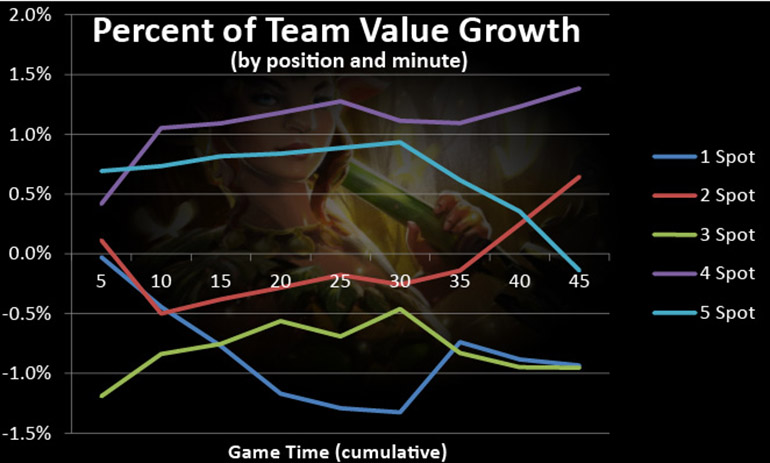The last two months have been a busy time for the Internet’s favorite milliner. Although it may feel like Rome rose and fell in a shorter time than it’s taking Valve to release the International immortals, in reality this newest patch has just begun to grow chest hair.
Six weeks ago, analysts, fans and pro players speculated what the changes we saw would mean for the game we love—those predictions were then hastily put on the shelf like so many useless knickknacks and never again approached.
Until now. We’re almost 800 professional games (as well as three full subpatches) into this patch. It’s time for us to look at the realities of 6.84 and see if our communal expectations aged like a fine wine or a bloated corpse.
Expectation #1: Games will have more kills and more action
I’ve seen some players refer to this as the “kill patch,” although I’ve always thought of it more as the “support patch.” The reduction of creep and jungle gold and the increase in kill bounties lead fans to believe that action will necessarily become a larger part of the game.
A lot of viewers still believe this to be the case. If you asked them how much more action 6.84 has than 6.83, their answers will usually range between “A little more” to “It’s like comparing Ken Burns’ The Civil War to the actual Civil War.”
Nothing really changed, pretty much regardless of how you define “action”: kills and hero damage are down and terrorists killed by Bruce Willis remains at a disappointing zero. The most prolific predictions (which I myself made when reading the patch notes) were that there would be more kills in the early and mid game, yet end-of-game kill count averages are essentially the same (although they even dropped very slightly) and kills per minute are the same.

Before the collective outcry from 1,000 armchair analysts (my brethren) call for my head on a spike for my cherry-picking data to skew it away from the beginning of the game, let me also say that kills at each stage of the game are minimally changed.
Let’s take some data which only includes averages from TI5 qualified or invited teams. Average kills for these teams have changed by less than half a kill for each five minute interval up to fifteen minutes. At about the forty minute mark the difference between the patches hits its peak at about 2 kills fewer, meaning the max difference for any stage in the game was not growth at all. In addition, it is minimal to the point of being inconsequential. Some teams, such as Secret, have seen an increase in kills, but the whole of professional Dota 2 has not.
Expectation #2: Games will be shorter
The savvy among you will note that I already said kills are unchanging, and kills per minute are unchanging. Those readers already figured out that there’s also no significant change in game time. There is a general misconception that 6.84C was released in response to habitually quick games, but the average time for a professional 6.84b games was only shorter than 6.83 by a matter of minutes. The reason this subpatch seemed so consistently short is a combination of short, high-profile series (notably at The Summit 3) and the fact that the prior subpatch had actually extended the average game to over forty minutes.

Moreover, the amount of variation in this patch is the same as in 6.83. In other words, it isn’t just the average but also the distribution of game lengths that is the same.
Expectation #3: Supports will be richer and carries will be poorer
As I said before, I consider this the “support patch” (not just because of the mechanics changes and new support-oriented items, but also because supports did not take nerfs and many non-support heroes were given buffs which increase their support viability). But are supports better off, or is this another myth? To answer this, I’ve taken the averages from The International qualifying and invited teams across both patches.

As it turns out, this is true but in an unexpected way. The poorest hero on the team has seen a his share of the team rise about .7% of the team’s overall net worth, while the second least wealthy player has had his value increased by over 1% of the team’s overall value. This shift comes largely at the cost of the one and three spot, both of whom traded out about .5 – 1.5% of the team’s net worth. Strangely, the second position, or the hero with the second-most gold priority on a team, has seen barely any change and actually takes a larger percentage of the team’s gold after 35 minutes.
This becomes less weird when you think about the nature of a second-position hero. Traditionally played out of the mid lane, a lot of this position’s value comes from rotations, ganks, and kills due to his ease of access to other lanes and inherent level advantage from a solo lane. In 6.83, almost every top team in the world used their mid hero as the recipient of the bulk of their early to mid game kills while the carry focused on creep genocide.
Now many teams, including Secret and EG, give large swaths of these kills to their farming carry to offset the approximately 7% GPM loss from the creep’s reduced economy.
As a side-note, some teams have always played with a much stronger emphasis on economic equality. During 6.82 I ran an analysis on this concept for a few teams over on datdota.com. Not surprisingly, the teams which had a more equal farm distribution before it was forced by game mechanics, Natus Vincere and Team Secret, are doing extremely well on this patch while many other teams have underperformed.
So what changed in 6.84?
Items, heroes, metagame. While the numbers seem relatively eternal, their execution has definitely made for a livelier viewer experience. You sure can arrange 20,000 hero damage in a lot of ways… and with a lot of victims! Next time I’m going to look at how item meta has changed in response to the addition of new items, economy changes, and other metagame considerations.
Photo credits: Flickr Daniel Pietzsch





1 Comments
Kiop
(163 comments)Bring back pls
April 19, 2016 at 8:44 pm